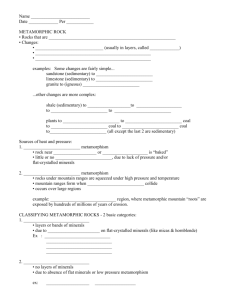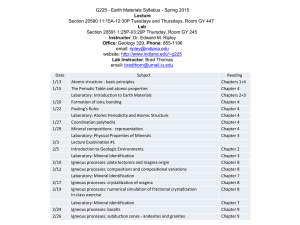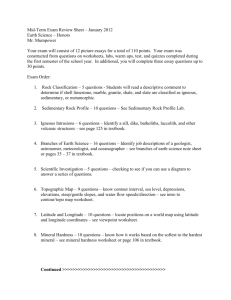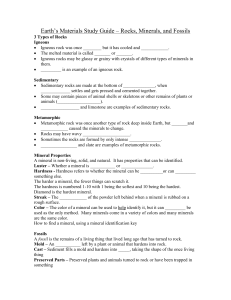Rocks and Minerals Pre-Test
advertisement
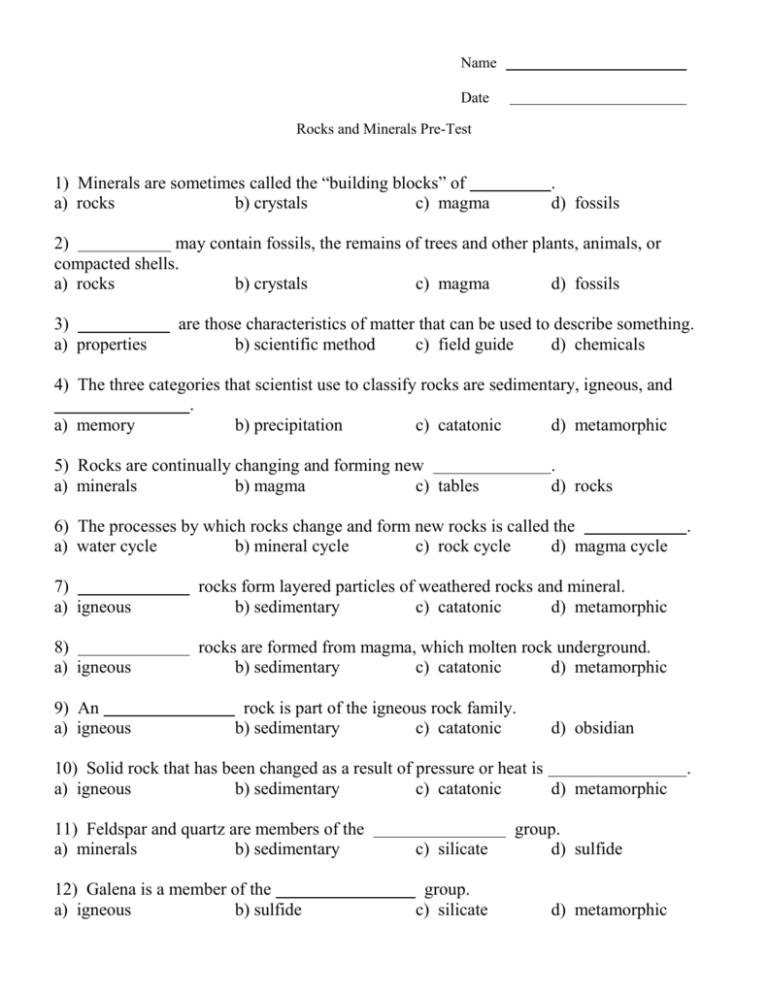
Name Date Rocks and Minerals Pre-Test 1) Minerals are sometimes called the “building blocks” of a) rocks b) crystals c) magma . d) fossils 2) may contain fossils, the remains of trees and other plants, animals, or compacted shells. a) rocks b) crystals c) magma d) fossils 3) a) properties are those characteristics of matter that can be used to describe something. b) scientific method c) field guide d) chemicals 4) The three categories that scientist use to classify rocks are sedimentary, igneous, and . a) memory b) precipitation c) catatonic d) metamorphic 5) Rocks are continually changing and forming new a) minerals b) magma c) tables . d) rocks 6) The processes by which rocks change and form new rocks is called the a) water cycle b) mineral cycle c) rock cycle d) magma cycle 7) a) igneous rocks form layered particles of weathered rocks and mineral. b) sedimentary c) catatonic d) metamorphic 8) a) igneous rocks are formed from magma, which molten rock underground. b) sedimentary c) catatonic d) metamorphic 9) An a) igneous rock is part of the igneous rock family. b) sedimentary c) catatonic d) obsidian 10) Solid rock that has been changed as a result of pressure or heat is a) igneous b) sedimentary c) catatonic d) metamorphic 11) Feldspar and quartz are members of the a) minerals b) sedimentary c) silicate 12) Galena is a member of the a) igneous b) sulfide group. c) silicate . group. d) sulfide d) metamorphic . 13) a) Igneous is the most common mineral on earth. b) Galena c) Feldspar 14) a) Minerals have several different kinds of observable color. b) Sedimentary c) Acorns d) Chalk 15) Geologist use a a) signs b) sedimentary d) Metamorphic to identify the properties of minerals. c) field test d) rope 16) Three descriptors that geologists use to describe a mineral’s light transmissivity are opaque, translucent, and . a) igneous b) transparent c) alpha centaury d) shadow 17) Many minerals are ; they transmit no light. a) transparent b) translucent c) trans world d) opaque 18) Some minerals are shined at them. a) transparent b) translucent c) trans world d) opaque 19) a) transparent transmit varying degrees of light. b) translucent c) trans world d) opaque ; they transmit virtually all the light that is 20) A mineral’s luster or shine depends on the way its surface reflects a) nothing b) black c) light d) opaque 21) Minerals that reflect light, like polished metal, are said to have a a) Gina tonic b) translucent c) metallic d) light 22) A mineral’s use is often related to its a) hardness b) translucent . luster. . c) metallic 23) Scientist classify the hardness of minerals using the a) tonic b) Mohs c) Kat d) Gina tonic scale. d) Newton 24) The standard that is based on the concept that the harder of two minerals will the softer. a) black b) opaque c) scratch d) chemical 25) and compasses. a) Magnetite’s special property is important because it has been used for magnets b) Transmissivity’s c) Metallic’s d) Mineral’s 26) The shape and size of minerals are the result of its a) black b) translucent c) metallic composition. d) chemical 27) Almost all minerals have a regular internal geometric pattern and a structure. a) Gina tonic b) crystalline c) metallic d) sleek 28) The process of minerals breaking into distinct shapes is called a) breakage b) fracture c) cleavage d) slippage 29) The absence of cleavage is called a) breakage b) fracture . . c) cleavage d) slippage 30) A is a reference book that presents information about the properties of rocks and minerals. a) properties guide b) rock book c) field guide d) mineral’s guide 31) An is any substance in a mineral that is not part of its identifying chemical composition. a) impurity b) acre c) imposter d) onion 32) The color of ranges from metallic gray to earthy red, depending on the presence of different impurities. a) biotite b) quartz c) hematite d) onion
